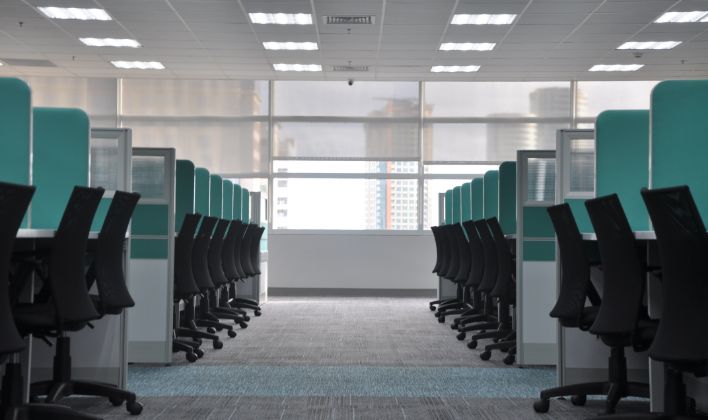In the event that the health crisis caused by COVID-19 has not taken your job away from you, it is likely that you are already thinking about this issue that has so much to do with de-escalation: abandoning remote working and returning to the workplace.
In short, going back to the office. And the answer, despite what some may think, is not so clear in fact.
Normally, more or less, we are lazy about change. Our organism is designed to function well in routine, the predictable, and the repetitive, although it is essential to combine this with certain doses of novelty from time to time. That is why, when we suddenly had to pick up our things, make room for the office at home, and get used to doing everything via telematics, the discomfort, and laziness made us complain a lot.

And now some are grumbling again about having to go back on that path while others are counting the days to unwind and return to their usual duties. There are those who, in spite of everything, have gained freedom, time, and comfort. Who appreciates eating better, sleeping more, and not spending hours or money on the subway? Not to mention those who prefer to de-escalate more slowly for health reasons. There are also those who live with anguish in the disruption between work, home, and professional life and are anxious to return to the old order. Remote working is never to everyone’s liking and the same goes for returning to the office.
In what ways have we changed?
It seems like an eternity has passed for almost everything, but in reality, it’s about who we were just three months ago. Some, specifically, weren’t much of a homeworker. Of course, that was before trying it for three months, you might say. And now we, the workers of that time, are no longer the same, they would add. We don’t like the same things anymore. We don’t need the same things anymore, or we do: we need them more than ever, and now we claim them. Others have always been in favour of remote working, but for an orderly, well-equipped, chosen and efficient remote working. The emergency has been dealt with in the best possible way, but now, looking ahead, they want to do it properly.
Some of them were not very keen on distance working before. Of course, that was before they tried it for three months. Now they’re not the same
Some, in short, want to go back to the office because teleworking has been a huge hassle for them but, beyond that, what they are asking for is an intelligent reconciliation of the different facets of their lives. As anyone would do.
How can we coordinate such different realities without the company suffering and without it seeming that, after so much “this has to change us [for the better]”, the indisputable presence, so inefficient and so typical of the Spanish labour panorama, is once again imposed?
An accomplished experiment
It is true that even before this epidemic there were companies – very few – with orderly teleworking policies for their workforces. It is also true that in many companies there were people -not so scarce- who demanded with a small mouth that these working from home policies be implemented. Both those who wanted to work from home and those who needed several days to adapt to this shock were subjected to a common fate: health required everyone to go home.

A good handful of weeks have already passed with the corporate computer installed in the living room, in that improvised office or even in the bedroom. During that time the experience of teleworking – whether desired or not – has taken on a life of its own as it has revealed an unexpected way of working. Now that the heads of each team are gradually dropping the idea of going back to the office, we all have a well-formed opinion about how we feel about this idea.
And there are opinions of all kinds, depending on the characteristics of the position and the particular circumstances of each one: what we need to be comfortable with, what our home is like, whether we need to separate rooms or whether it is good for us to vegetate indefinitely in the confinement of the home. Of course, if we live alone or in the company of (oh, terror) children and other factors that can make the scale turn towards the home office or the real one.
The fact is that, just as all that shine at the moment of leaving the office and settling down at home was not gold, neither is all that shine now at the prospect of dismantling the domestic stand and reinstalling ourselves in the usual space that we abandoned sometime in the first two weeks of March.
Closing the offices and imposing home-based work was mandatory, but interrupting teleworking and imposing a return to the office is, in many cases, unnecessary. This raises an important question for us at work: what is the best option for our company? And to this is added another crucial question: what portion of what is the best option for our company is answered by taking into account what is most important for our workers?
Before 14 March 2020 most companies were unable to justify how their operations would be affected if a small, medium or large part of their workforce had to work from home. They simply did not know. In the meantime, they were resisting tenaciously to give it a try.
Three months later the experiment is done in its most intensive and extensive version. There is no longer any room for guesswork, rather the facts speak for themselves. And, within the enormous diversity of results, the facts say that for many companies teleworking has not only been a viable option but has been a positive one, at least in some ways.
Thus, that teleworking is not feasible for a company like ours is going to be very difficult to argue from now on for many management teams, as it is as obvious as if we have been able to do the same from home as in the office is that it is possible. How much of this is good for the assignment (outcome, money) and how much is good for the employees (human beings) is a different matter. There is no point in cheating to find out: you have to ask those employees, not just look at the bottom line.
In any case, the time – hopefully inexorable – of de-escalation dictates that decisions must be made. Also in the offices. Or in the living rooms of the houses.
Therefore, if you consider that returning to the office is essential for your team’s smooth running and that teleworking has been a provisional arrangement while waiting to resume normal operations, then there is little to say and the only thing left to do is to carry it out as safely as possible.
However, if it is not so clear that the physical presence of your workers in an office is essential for the company to succeed, then don’t rush into a decision about it.
It was about getting out of it in better shape, wasn’t it? To learn, to improve, to be a resilient company. The opportunity to make this a reality began when we bolted the office and that’s what we’ve been striving for during the long weeks of confinement. Now this goal needs an equally significant boost. As well as smart.
Ask your employees
You want to know what’s best for them? Don’t assume, ask them openly. It is very difficult to completely satisfy the aspirations of all, especially if they are many and with very different circumstances. Still, ask them. They will give you information that will be very useful for you to decide, they will feel that they are being taken into consideration (and they will feel it even more if you later explain the decision to them properly). It will also give you a more accurate perspective on the reality of your team at this time. Remember: the boss assumes, the leader asks.
New times, new organization
There’s not a single option to go back to the office. Fairly calibrate the needs of your business and the characteristics of your team (or, if you’re more sensitive, the needs of your workers).

You have different options, design among all which plan is the best for most: at the extremes are to all return to the office or to all continue teleworking. In the middle you have to leave the option for whoever wants to come back and whoever wants to stay at home. Another possibility is to set some days of optional teleworking and other days of compulsory attendance, or to make rotating shifts by weeks. It’s about money, don’t forget, but also about being consistent and making a majority of the staff as comfortable as possible.
Security measures
Make sure your company has a clear, explicit and realistic security protocol for the return to the office. Also make sure that all staff are aware of it and are prepared to implement it. If necessary, rehearse it. Work rooms, rest areas, the bathroom, the dining room, even something as silly as the front door can become a health problem if we don’t adjust the timetables and uses of the spaces properly.
The office must allow for physical distance between workers, who must have access to hydroalcoholic gel and know whether the use of masks or latex gloves is obligatory or optional in the company (remember that the official standard indicates that, in general, masks are obligatory as long as the physical distance cannot be guaranteed; you decide if it is obligatory in your company even if it can be guaranteed). Ask yourself these questions: are you willing to have your team spend several hours each day with a mask on rather than being at home with their face uncovered doing the same task, is your team open to it?
Consider the risks carefully
No one questions that staying at home is not always the best option for any worker or any company. However, before you move a group of people (even hundreds of people) in an impulsive or disproportionate optimistic way, think that if one member of the office gets sick you will have to arrange a retreat of everyone for at least two weeks. Ask yourself these questions: is it worth it for the company, are the workers prepared?
Intimacy problems
Returning to the office in the current circumstances can put more than one boss and more than one employee in a compromising position. We are taking for granted that we are all young and healthy, all responsible and negative for COVID-19, all with the same family and personal situation. All of us are always ready, like a big and vibrant group of boy scouts.
But that’s not the case. Ask yourself the following questions: What percentage of your staff has passed the COVID-19, what portion has not and what portion is now asymptomatic? Are you going to ask them? Do they know? Are you going to do tests to check? How? Are you going to consider that there may be people in your team with health circumstances that make them especially vulnerable but not easy to disclose (pregnancies, chronic diseases, etc.)? Are you going to ask them? What right do you have? If you do, how will you safeguard their right to privacy? All of this can be relatively easy to save if you stop to think about how to do it properly, or if you have a close trusting relationship with your workers, of course. The question is: is it worth it for your company?
Join the global leading solution in mental well-being
Seize the opportunity
As in so many other aspects of the health emergency we are going through, it has been essential to generalize in order to be able to talk about something, but in reality the casuistry is infinite.
There have not been two equal confinements, not at all, but if there has been one muscle that we have all had to train over the last few months, it has been flexibility. Now that we are fully involved in this uncertain period of de-escalating, it is important that we do not lose tone in these fibers… especially if rigidity (if coming back because of it, or teleworking because of it) is not essential.
The balance between teleworking and physical attendance has to be useful for all parties involved
Gaining time, freedom and comfort have been some of the great conquests for many people during their experience as teleworkers. Others, however, will remember the disordered schedules, the lack of separation between spaces and times, the feeling of living worse or of being a lousy parent and also a lousier worker. At the end of the day, there is a reason for experiments: we can have a hypothesis but then we have to confirm it with the result.
The important thing, in any case, is that those people who have managed to improve their work-related health during these weeks find a way to put this discovery at the service of their company, so that the company does not discard it. It is also desirable that the balance between teleworking and attendance is precisely that, a useful and efficient balance for all parties involved, not only for the final product from which the company lives.
It’s not easy, but now that everything is up in arms, it’s time to be brave and face up to better ways of working, regardless of whether they are new or old. Heads and employees have different shares of responsibility in this. Hopefully they will come to a good agreement.









